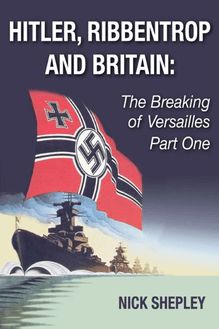Britain, France and Germany and the Treaty of Versailles , livre ebook
17
pages
English
Ebooks
2015
Vous pourrez modifier la taille du texte de cet ouvrage
Obtenez un accès à la bibliothèque pour le consulter en ligne En savoir plus
Découvre YouScribe en t'inscrivant gratuitement
Découvre YouScribe en t'inscrivant gratuitement
17
pages
English
Ebooks
2015
Vous pourrez modifier la taille du texte de cet ouvrage
Obtenez un accès à la bibliothèque pour le consulter en ligne En savoir plus
Publié par
Date de parution
07 décembre 2015
Nombre de lectures
0
EAN13
9781849899413
Langue
English
Publié par
Date de parution
07 décembre 2015
Nombre de lectures
0
EAN13
9781849899413
Langue
English
Title Page
BRITAIN, FRANCE AND GERMANY
AND THE
TREATY OF VERSAILLES
HOW THE ALLIES BUILT A FLAWED PEACE
By
Nick Shepley
Publisher Information
Britain, France And Germany
and the
Treaty Of Versailles
Published in 2011 by
Andrews UK Limited
www.andrewsuk.com
This book is sold subject to the condition that it shall not, by way of trade or otherwise, be lent, resold, hired out or otherwise circulated without the publisher’s prior written consent in any form of binding or cover other than that in which it is published, and without a similar condition being imposed on the subsequent purchaser.
The characters and situations in this book are entirely imaginary and bear no relation to any real person or actual happening.
Copyright © Nick Shepley
The right of Nick Shepley to be identified as author of this book has been asserted in accordance with section 77 and 78 of the Copyrights Designs and Patents Act 1988.
Introduction
John Maynard Keynes, the British economist and a member of the delegation at the Paris Peace Conference and the Treaty of Versailles at the end of World War One said in his book The Economic Consequences of the Peace, written in 1920 that: “The Treaty includes no provision for the economic rehabilitation of Europe - nothing to make the defeated Central Powers into good neighbours, nothing to stabilise the new States of Europe, nothing to reclaim Russia; nor does it promote in any way a compact of economic solidarity amongst the Allies themselves; no arrangement was reached at Paris for restoring the disordered finances of France and Italy, or to adjust the systems of the Old World and the New.
It is an extraordinary fact that the fundamental economic problem of a Europe starving and disintegrating before their eyes, was the one question in which it was impossible to arouse the interest of the Four. Reparation was their main excursion into the economic field, and they settled it from every point of view except that of the economic future of the States whose destiny they were handling.”
It was deeply troubling to Keynes that the victorious powers in 1918 seemed to be creating a world that was riven with instability. However some onlookers were amazed that with the size of the problems that existed, that any peace was made at all.
What Did The World Look Like In 1918?
Four long years of a quite unexpected and extraordinarily savage war, one that had not just affected Europe but large parts of the Middle East, Africa and even Asia, had left the great civilisation of Europe devastated.
Large parts of France and Belgium had been fought over constantly for most of the past four years, houses, factories, schools, railways, farms and whole towns had been destroyed, with catastrophic loss of life. The countries that had not actually been invaded had suffered none the less. The German, Austrian, Russian and Ottoman (Turkish) Empires had all collapsed, and the debts accumulated by the British and French Empires made their long term existence extremely unlikely.











